The Small Satellites of the Outer Solar System
All the giant planets of the solar system are surrounded by
"mini-planetary systems". We can emphasize the 4 galilean satellites (Jupiter), Titan (Saturn) and Triton (Neptune),
analysed in other sub-chapters. 12 middle sized satellites (Mimas, Enceladus,
Tethys, Dione, Rhea and Iapetus in Saturn; Miranda, Ariel, Umbriel, Titania and
Oberon in Uranus; Proteus in Neptune) and at least 39 small dimension
satellites (12 in Jupiter, 11 in Saturn, 10 in Uranus and 6 in Neptune) also
orbit these planets.
The
System of Jupiter
4 of the 12 smallest satellites of Jupiter orbit in the interior of its
system, while the other 8 orbit in the exterior.
The latter ones can be sub-divided
in a less external group and in a more external group, each comprising 4 satellites. Of those, the ones belonging
to the more external group are characterized by their clockwise orbits
(opposite to the counter-clockwise rotation of Jupiter). These 8 bodies may
probably have their roots in 2 bodies formed far away from the planet, which
would have been captured by it in a later time. Even later, the collisions with
other asteroids or comets would have provoked a fragmentation
of these objects, giving birth to the two detected groups.
In the interior of the system, the satellites would have presumably been
born close the planet but their proximity to this and the resulting tidal forces would have
prevented their gathering into larger bodies.
The
System of Saturn
Mimas (with a diameter of only 390 km, slightly more than enough to give
it a spherical shape) and Enceladus (with a diameter of 500 km and slightly
farther away from Saturn) are the innermost and the smallest of the
intermediate sized satellites of Saturn. Tethys (with a
diameter of 1050 km), Dione (1120 km) and Rhea (1530 km), are the following
ones, as we go away from the planet. Iapetus (1140 km), lies far beyond the
orbit of Titan, and is by far the most
distant of the intermediate satellites. All the intermediate satellites of
Saturn are bodies composed essentially by water ice. However, while Mimas,
Tethys, Dione, Rhea and Iapetus are densely covered by craters, they seem to have been almost
completely erased in Enceladus.
Enceladus
Enceladus apparently went through a phase of intense geological
transformation, which is suggested by the degradation conditions of the craters’
rims and by the complex linear features that frequently superimpose over the craters.
The origin of this activity, revealed in the form of water vulcanism,
should have its roots in tidal forces (just like Io and Europa), determined by the interactions
with Saturn and Dione, which has an orbital period approximately twice
that of Enceladus, meaning that it is almost resonant. This resonance with
Dione, given the assumption that it was accurate in the past, would have thrown
the satellite into an eccentric orbit and, therefore, would have been the
responsible factor for the mentioned tidal forces.
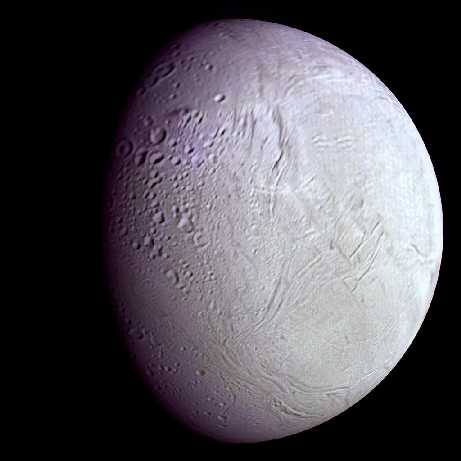
Enceladus (A. Tayfun Oner)
Mimas
The largest crater of Mimas (Herschel),
with a diameter extending for more than 1/3 of the satellite’s has dimensions
that are close to the critical value beyond which it would have been broken
into pieces after the collision.
It’s quite possible that Mimas was, in an earlier time, destroyed by one
of those impacts and the fragments of the ring that resulted from them
accumulated again to form the body that we know today.
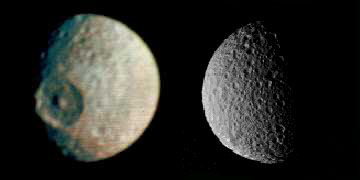
Two hemispheres of Mimas:
to the left, the crater Herschel (Calvin J. Hamilton)
Tethys and Dione: Geological Activity
Tethys and Dione, less than Enceladus, appear to have been affected by
resurfacing processes, unveiled by canyons crossing long distances.
Tethys would have been mainly liquid in the beginning and, later, would
have entered a phase of crust expansion as a consequence of the freezing of its
interior (the water expands when it freezes, contrarily to what happens with
most materials). So, its surface would have been fractured, originating part of
the detected features.
The largest crater of Tethys, Odysseus,
seems to have been flattened and stripped of remarkable reliefs, which would be
explainable if it had been formed in an early phase of the solidification
process, during which the geological features would easily fade.
In Dione it is remarkable a brilliant region, located in the trailing
hemisphere (the back side of the satellite concerning its movement), which is
the centre of a light grooves and ridges’ system. This region seems to have
been, in the past, the centre of some geological activity.
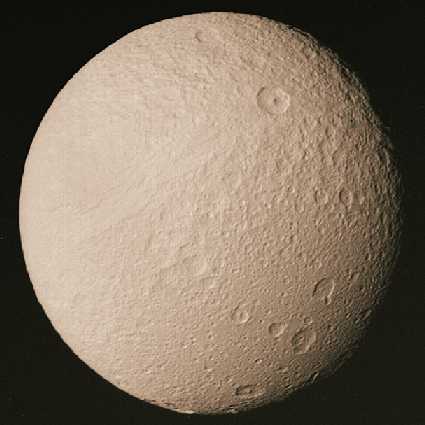
Tethys (Calvin J.
Hamilton)
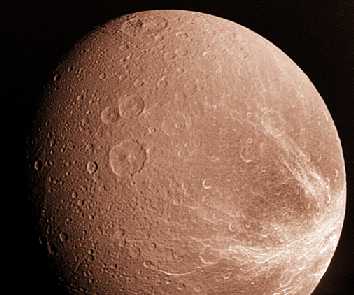
Dione (Calvin J.
Hamilton)
Dione and Rhea: Micro-Cratering
Dione and Rhea are characterized by a remarkable asymmetry of the
reflectivity (albedo) between the leading (the front side of the satellite
concerning to its orbital movement around Saturn) and the trailing hemispheres
(the back side, facing to where it was just before). The leading hemispheres
display more or less uniform reflectivities, while the trailing hemispheres are
characterized by structures of bright features lying over a dark background.
The leading hemispheres may have been optically uniformed by a more
intense process of micro-cratering, which would result from the movement of
these satellites concerning to the rainfall of tiny projectiles (meteors),
orbiting around Saturn. That movement would have then favoured the impacts against
the leading hemispheres of both.
The observations also suggest the existence of a population of small and
middle-sized meteorites, orbiting around Saturn and that would have intensely hit some of Dione’s regions in
a period of late bombardment. This population could have been the result of the
destruction of one or more large dimensions objects.
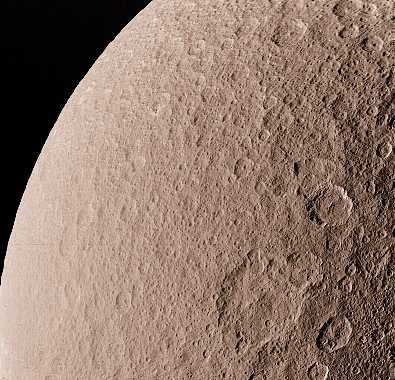
Detail of Rhea’s surface
(Calvin J. Hamilton)
Rhea: Tranquillity
Contrarily to Tethys or Dione, in Rhea there aren’t big signals of
evident inner activity or fractures resulting from the freezing and expansion.
Neither it is reasonable to take into account any “phoenix bird” hypothesis,
according to which this satellite could be a body that was re-built from the
fragments of the destruction of previous bodies (as it probably happened in
Mimas or, less likely, in the case of the other two bodies mentioned above).
The biggest mass and gravity of Rhea may explain why, i this particular case,
this hypothesis would have been made particularly difficult.
Iapetus: Black and White
Iapetus is remarkable for the huge reflectivity difference between the
leading and the trailing hemispheres. The satellite is almost entirely composed
by ice, but in the leading hemisphere its luminosity is as dark as coal, while
in the trailing hemisphere it is as bright as snow.
It’s possible that the origin of the black colour of the leading
hemisphere is related with Phoebe, a very dark satellite that orbits Saturn at a higher
distance. The interaction with the radiation may release small particles from
its surface, which further travel fast in a backward direction, until some of
them intercept Iapetus.
The difference between the brightness of both hemispheres can also have
an internal origin, because the borders between the bright and dark zones are
sharp and irregular, contrarily to what should happen if the phenomenon could
be explained by external processes. The dark bottom of the craters in the
bright hemisphere (trailing) of Iapetus also suggests this hypothesis may be
the most reasonable one.
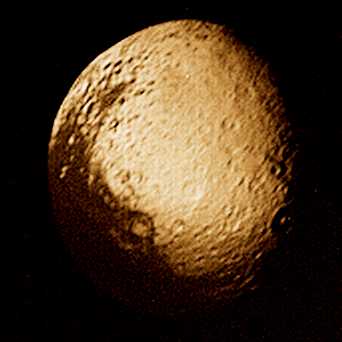
Iapetus: to the left –
the dark hemisphere, to the right – the bright hemisphere (Calvin J. Hamilton)
Phoebe
Phoebe, the possible source of the particles that dye the leading
hemisphere of Iapetus, is a small satellite (with a diameter of 200 km) with a
nearly spherical shape and that may probably have been captured by Saturn in a remote time. Its long permanence in the system
suggests that it may have been braked by the friction with the gaseous
environment that surrounded Saturn during the time of its formation.

Image of Phoebe taken by
the Cassini probe in June, 2004 (NASA-JPL)
Hyperion
Hyperion, which is satellite that is placed between the orbits of Titan and Iapetus, appears to be a
fragment of a big object destroyed in a violent impact during the primordial
phases of the solar system history. That hypothesis is favoured by the
exaggerated irregularity of the satellite given its big dimensions (shorter
axis: 230 km, longer axis: 410 km) and by its eccentric orbit.
The object that was in the origin of Hyperion may also be responsible
for the already mentioned population of small and middle-sized meteorites that
long ago would have orbited around Saturn.

Hyperion (Calvin J.
Hamilton)
Micro-Satellites
5 small inner satellites of Saturn are directly linked to the shape
patterns of the rings, limiting their
dimensions. Two other satellites orbit Saturn at the same distance of Tethys,
forming with the latter an angle that the celestial mechanics defines as
equilibrium point and that allows them to stay in that position for a very long
period. The satellite Helene is placed at an orbit close to Dione’s, also in an
equilibrium point in relation with this satellite and Saturn.
The
System of Uranus
The main satellites of Uranus – Miranda (with a diameter of 470
km), Ariel (1160 km), Umbriel (1170 km), Titania (1580 km) and Oberon (1520 km)
– seem to be richer in rocky material than
the satellites of Saturn.
Miranda: The Exotics
Miranda, although it is the smallest of these satellites, displays an
extraordinary variety of geological features like hills, fractures, faults,
canyons, parallel strips’ systems and mountain chains with diverse morphology.
The most ancient regions of Miranda are intensely covered by craters which, given the properties of the
surface materials, hold relatively shallow reliefs. In other zones, the crust
seems to have been deformed and stretched, forming deep folds and leaving
uncovered materials with different optical properties.
There are two hypotheses that try to explain the peculiar
characteristics of Miranda:
- One states that Miranda, just like
Enceladus, may have been recently affected by resonance and tidal heating
phenomena. This would have been enough for stirring up extensive tectonic
and volcanic processes;
- Another hypothesis advocates that
Miranda, like other bodies in the solar system, may be an object that was
reaccumulated from the fragments proceeding from another body previously
destroyed by an impact. That would have produced a mosaic surface,
overlaying regions of different fragments, some proceeding from the
surface (rich in ice) of the parent body and others proceeding from its
interior (with a much more significative rocky component). After the
reaccumulation, a differentiation process could have been stirred up,
favouring the sinking and melting of the rocky regions. The energy
produced through this process would have been, according to this
hypothesis, the responsible factor for the fractures and volcanic
phenomena.
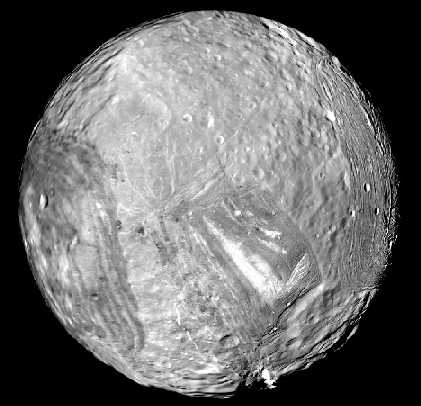
Miranda (A. Tayfun
Oner)
Ariel
Ariel displays a less exotic surface than Miranda’s, but displays clear
signals of geological activity. The largest craters seem to have been erased
from the surface, and the largest survivor of them has a flattened bottom,
which may have been caused by the slackness of the material under the effect of
the gravity.
The cratered terrains are crossed, interrupted and sometimes seem to
have been displaced by a global system of faults and fractures, which could
have resulted from the freezing of the water that would have provoked the expansion
of the crust. Very viscous material, expelled from the interior during the
expansion phase, would have been laid in successive phases over the most
ancient terrains.
Ariel seems to be composed by water ice mixed with ammonia and,
eventually, some methane and carbon
monoxide. The rocky material existing in Ariel, along with the eventual
resonances and tidal forces, may have been the main factor that caused the
heating of the satellite, given its primordially radioactive properties.
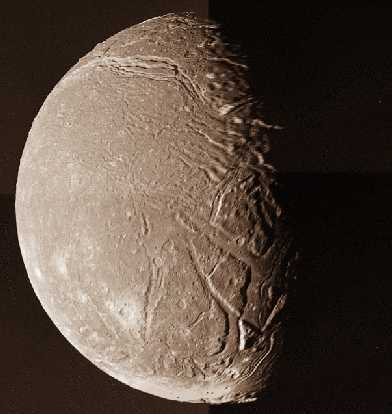
Ariel (Calvin J.
Hamilton)
Umbriel: The Darkness
Umbriel is a very dark satellite and displays a uniform brightness. It
has a surface intensely crowded with craters. The cause of the uniformity of the
surface brightness may have been the occurrence of an impact that expelled a
large quantity of debris from the satellite, which in turn would have been
intercepted and collected again by Umbriel. The debris would have then covered
Umbriel with a thin layer of dust.
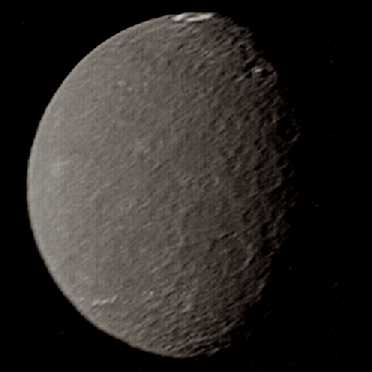
Umbriel (Calvin J.
Hamilton)
Titania and Oberon
Just like Ariel, Titania and Oberon display regions of diverse
reflectivity, the darkest ones being probably rich in carbon composites,
similarly to the ones that are found in the carbonic chondrites.
Titania is densely populated with craters, but it displays
flatter zones that may have been covered by aqueous volcanic material whose
expulsion from the interior, like in the Moon, would have been stirred up by the energy released by the
largest impacts. The system of fractures and cliffs, as in Ariel, may have been
caused by the expansion of the crust provoked by the freezing of the water.
In Oberon, as it happens on the bright hemisphere of Iapetus, the bottom
of the craters is dark and probably rich in carbon. This material may have been
deposited there through the ocurrence of eruptions provoked by the impacts, in
a similar way to what happened in Titania. Oberon seems, nevertheless, to be
deprived of structures that might reveal processes of surface renewal.
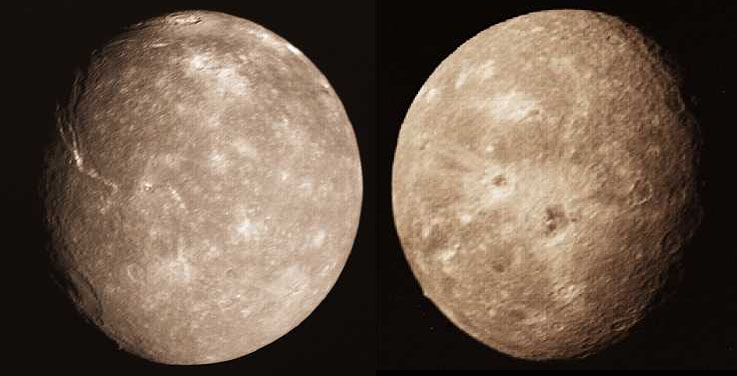
To the left: Titania, to
the right: Oberon (Calvin J. Hamilton)
Micro-Satellites
Such as the rings of Saturn, the rings of Uranus are also confined by the
disturbance caused by the "shepherd satellites", namely in the case
of the Epsilon ring, whose edges are imposed by the trajectories of the
Cordelia and Ophelia satellites.
The System
of Neptune
Proteus
Proteus, with a diameter of 420 km, is a satellite with dimensions
comparable to those of Mimas, Enceladus and Miranda. However, its shape is
somewhat irregular, contrarily to the spherical shapes that characterize these
3 satellites. It’s thought that it stands at an intermediate point between the
high mass spherical bodies and the low mass tri-axial bodies (with 3 axis of
different dimensions).
The high density of craters reveals the old age of its surface.
The largest of them, Pharos, covers more than a half of the satellites’
diameter. As it clearly exceeds the critical point at which a regular satellite
would have been destroyed by the impact, it is thought that the surface layers
are composed by porous rather than compact material, plenty of internal
cavities.
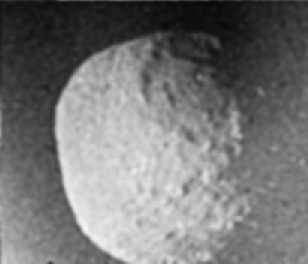
Proteus: above, the
Pharos crater (Calvin J. Hamilton)
Micro-Satellites
Out of the 6 small satellites of Neptune, the largest – Nereid, holds the
most eccentric orbit of the solar system (it approaches Neptune to a distance
of only 1,4 million km during the perihelion and gets away from it up to a
distance of 9,7 million km during the aphelion). Besides that, it has a
reflectivity (albedo) that exceeds twice the reflectivity of the other small
satellites. Therefore, it is thought that it is a body that was captured by the
system in a time posterior to the formation of the system of Neptune.
Out of the remaining 5 satellites, 4 are placed inside the system of the
thin rings of Neptune and it is thought that
they were formed from the debris of 2 larger satellites that were fragmented
after collisions with asteroids or comets. The 5th satellite, Larissa, is
placed slightly farther away, between the orbits of Galatea and Proteus. The
satellites that, during the ancient times, presumably existed in the zone of Triton were probably swept by the
gravitational disturbances that would have been provoked on them immediately
after the capture of that large satellite by the system of Neptune.
_